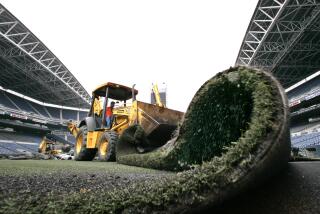Four ways to remove your lawn
YOU’D THINK it would be easy to murder a lawn, since many of us have had plenty of success without even trying. But finishing off that green sponge takes a smart strategy, or it may come back to haunt you.
Removing lawn seems basic enough: Dig it up and haul it away. But it’s best to subordinate reflex and forgo brute hacking, experts say. First of all, yanking out sod “can be back-breaking work,” says Steve Gerischer, a Glassell Park landscape designer who gives talks on turf termination for the Theodore Payne Foundation for Wild Flowers and Native Plants as well as the Los Angeles County Arboretum. The big-dig method can cause other problems too, removing too much topsoil and inciting the growth of crab grass.
“Don’t dig up your lawn if you have Bermuda,” advises Barbara Eisenstein, horticulture outreach coordinator for the Native Plant Garden Hotline, a collaboration between the Metropolitan Water District and Rancho Santa Ana Botanic Garden. “Don’t rototill. All you’re doing that way is planting the grass, because it grows from the stems.”
Gerischer says people often make the mistake of hiring a crew that just skims off the top of the lawn, leaving the root system. You’re left with the Lawn That Will Not Die. “It can be hard to kill a lawn when you don’t do it right,” he says.
That means bumping off the grass before you dig. Claremont resident Andrea Gutierrez, online marketing director for flower grower Monrovia, stopped watering her front lawn, and after a month it browned out. “We were sure the neighbors were freaking out,” she says.
She and her husband then plowed the turf, attacking it with a rented mini-Bobcat excavator, counter to the advice of experts, who recommend disturbing the soil as little as possible to avoid activating weeds. The couple did wind up with residual weeds, but the result is a garden of lavender, blueberries, fig trees and blackberries.
The excavation approach is just one way to go grassless. Other options:
Layering. This approach is increasingly popular among those who want to avoid chemicals, but it takes time. Cover the turf with six or more layers of cardboard or newspaper. On top of that, add 4 to 6 inches of organic mulch -- chopped bark, leaves -- and water. The layers prevent any light in or growth up. Grass dies in two months. Then you can dig right through the mulch and newspaper and plant in the soil.
Solarizing. This variation on the layering approach uses the sun as executioner. First, mow the lawn super-close. Then water it intensively. Cover it with a plastic tarp to hold in the moisture and let the sun sweat the turf to death. Downside: This process takes about six weeks and can leave the neighbors wondering when you’re going to start the painting.
Spraying. Many gardeners prefer not to use herbicides, but Tom Smith, a turf specialist with the Institute of Agricultural Technology at Michigan State University, says an agent such as Roundup is one way to go, particularly if you’re going to replace the grass with something else. The spray is “absorbed by the plant and root system but doesn’t have a soil residual,” he says. Spray it once or twice, and in seven to 10 days the fescue has moved onto the big golf course in the sky. “It’s the simplest solution,” says Catie Lee, who runs CRL Landscape Design in Encino. She says that almost all of her clients are trying to lower water consumption and are looking to replace some of their lawn.
--






